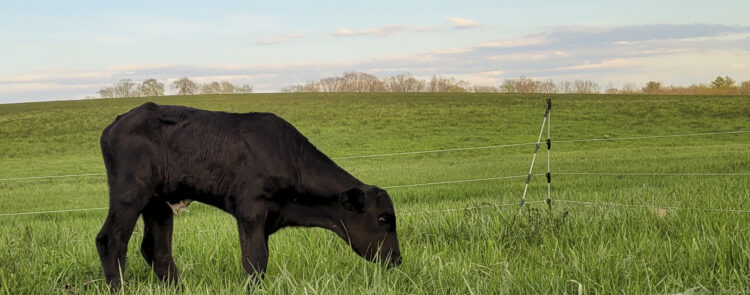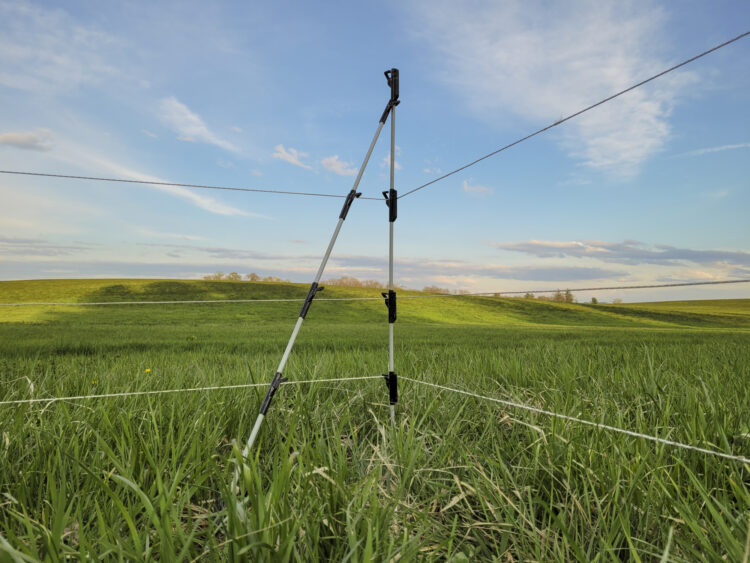BLOG

Your Grazing Toolbox - Step-In Posts
As the troughs start to thaw, the landscape begins to reveal Spring. Trees begin to blossom and grass begins to grow. This is the time of year graziers get excited! Are you ready to capture all the potential that Spring offers?
Grazing, just like any occupation or industry has its own tools of the trade. Often a task is made easier just by knowing the right tools to use for the job. Kencove Farm Fence is a “Swiss Army knife” for the grazier where you can find numerous options to fit the job at hand. With Kencove, you can choose how to manage that rapid forage growth so your livestock munches till they are content. In this blog we will discuss some tools for your grazing toolbox, specifically Step-In Posts.
People always ask "what can I plant to produce more forage and graze longer into the year?". A great answer from one of our local NRCS agents is “Posts!” When planning grazing season, the more paddocks the better. After all, we are not planning paddocks for long periods of grazing but more so for periods of recovery. More paddocks equal longer recovery and this is accomplished with “Posts”. Line posts do not have to be telephone beams or grandpa’s old leaning posts. Today there are many options available to the grazier.
My personal post quiver consists of 3/8” SunGuard step-in posts with pre-molded clips (F38SSG) and O’Brien’s Treadaline posts (RRTW-White/RRTY-Yellow/RRTBU-Blue) and the occasional t-post. All 3 can be excellent choices but sometimes budget dictates which one that best fits your grazing plan.
The O’Brien’s has been a top choice for many graziers. They're lightweight, flexible, 36” height from ground features a long-galvanized, small diameter spike that is embedded above the step for superior strength. This small spike ensures less resistance when stepping into the soil and makes it easy to step into any ground, including rocky or frozen. I've personally managed bale grazing paddocks through a Pennsylvania winter with O’Brien’s posts. The multiple color options proved to be helpful for making a temporary line more visible to livestock with a 14” whiteout and with constant flurries. These posts will flex and take abuse, mine have survived a bull rolling a round bale over them. If your operation is anything like mine, that is the performance I need in a post!
The O’Brien’s provides you with 8 twine and 4 tape clips spaced so you can set up fence to fit your livestock scenario. My operation consists of Scottish Highlanders so one strand of twine at 24” (6th Clip from bottom) works perfect. Multiple twine or tape clip heights, sturdy step with metal spike, premium grade UV-stabilized polymer and multiple color options, it is no wonder the O’Brien’s is a top choice.
The 3/8” SunGuard step-in posts (F38SSG) stand at 38” from ground with 4 twine or tape pre-molded clips. These posts are SunGuard coated from top to bottom, including the ground-penetrating spike. SunGuard uses a high-quality plastic for the innovative 4-way fin step-in foot and clips to ensure stability and long life. If you are challenged with rocky or frozen ground, you can drive in this post because the top clip doubles as a drive cap. What draws me to the SunGuard posts is the price point and the rigidity. When using this post, I place my twine at 26” (3rd clip from bottom) for that perfect height. At almost half the cost of an O’Brien’s I can “plant” 2 SunGuard posts for around the same price of 1 O'Brien's. The 3/8” diameter gives the post more rigidity/structure and integrity when compared to the O’Brien’s. I choose the SunGuard post for starting and stopping runs, curves or directional changes and I even hang my reel from these posts. In the case of direction change or focused tension, I have found the use of two SunGuard posts to be adequate. Doubling up two posts side-by-side to share the tension or a vertical post with a second post positioned at an angle, inter-locking clips. This makeshift diagonal brace prevents the vertical post from succumbing to the demand of high tension.


Two Quick tips for using step-in posts. Similar to principals of High Tensile fencing, position the post so twine or tape presses against post, not pulling on the clip. This ensures the post is carrying the tension rather than the clip as the shaft is sturdier than a clip. Another practice I have learned is to rotate the post so the clip surrounds as much of the twine as possible. Instead of making the step-in post perpendicular to the twine (line of the fence), rotate it slightly towards the open end of the clip. This makes it near impossible for twine to pop out of the clip. When aligned perpendicular to the twine and pressure is applied close to the post (in my experience from two steers rough housing, a tree branch falling and leaning, wildlife traffic or all the above), it can push the twine past the release point. Rotating the posts to encompass as much of the twine inside the clip as possible avoids that.

At the extreme points of tension, corners, dips, or rises I might prefer the use of a t-post. These can handle all the tension from a twine or tape without requiring additional bracing. Due to the nomadic nature of rotational grazing, mob grazing, holistic planned grazing, intensive grazing – whatever method you use – these posts will most likely be left in place for use during the next grazing event. When you cycle back around these posts will be there to remind you how you set up the shape of the pasture previously. Planning the layout of pastures and paddocks can take time and brain power, however leaving a few key marker posts behind reduce you questioning yourself, “Where did I put that corner last time?” or “How did I divide this section?”. The more trips you take up and down the fence line, the more hours spent re-configuring posts, and the more head scratching reduces efficiency and defeats the simple and quick nature of rotational tools. Ultimately, this waste of man hours creeps in on your bottom line like a multiflora rose.
Posts are the structure of your fence, just like a skeleton. A properly aligned skeleton allows proper function for the rest of the body.
Set up fencing in a way that compliments your grazing plan. Whether you are moving a few cattle, sheep, goats or chickens to the next buffet of brush or to rotate a mob, choose the right tool for the job.
Contact a Kencove Product Specialist if you need helping finding the tools for your Grazing Plan.
Get out there and get Grazin’!
Mack Farms
Pennsylvania Grazier




